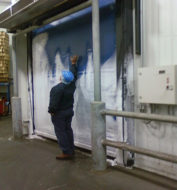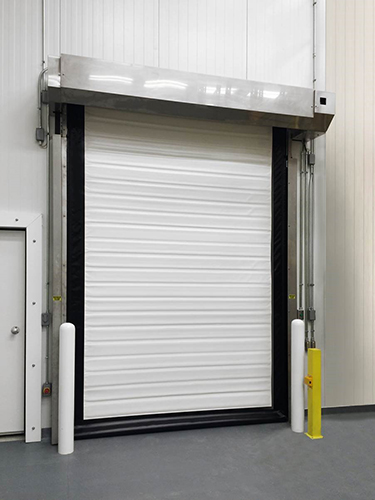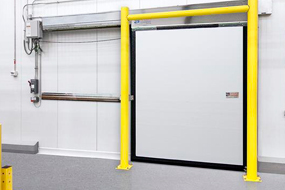5 Ways to Reduce Energy Costs In Cold Storage Warehouses
One of the highest operating costs for refrigerated and cold storage facilities is energy. Massive amounts of energy are needed to maintain stable temperatures, especially in storage facilities specializing in perishable refrigerated and frozen foods.
Managers and operators of these facilities are constantly looking for ways to balance energy costs and temperature stability. The best solution lies in leveraging new technologies and modern equipment that guarantee the product is protected and your bottom line is not affected.

Let’s look at a few strategies for lowering energy costs while keeping the required operational temperatures stable:
-
-
Maximize Equipment’s Design Efficiency
-
Each refrigeration system features an ideal output that yields the highest efficiency when need be. It is common for operators to run their equipment below the system’s peak design efficiency so that they maintain a stable temperature and cut energy consumption. However, to optimize efficiency, you should strive to run your system with a “fully loaded” design output. Typically, the systems running at 100 percent of their peak for more time tend to idle for more prolonged periods resulting in lower power consumption and reduced costs.
-
Prioritize High-Speed Opening and Closing Cold Storage Doors

615F Insulated Freezer Door
This measure might seem obvious, but many facilities fail to track the performance of their doors as often as they should. When it comes to design features, you should go with modern high-performance industrial freezer and cooler doors. Such doors are uniquely designed and customized with energy efficiency in mind. The doors are made using energy-efficient materials with higher R-values to reduce heat loss due to conduction.
The largest energy load in a cold storage facility is from infiltration of warm/humid outdoor air and leakage of refrigerated air to the outside atmosphere. An improperly sealed door will let the cold air escape and force the refrigeration units to work harder to maintain food quality. High-performance freezer and cooler doors come with uniquely designed seals that reduce air infiltration and exfiltration. These seals are mounted along the perimeter of the opening and provide tight sealing when you close the doors.
In addition to needing higher R-values and tight seals, it is important to determine the opening and closing speed of your refrigerated doors. A door that opens and closes slowly lets in large amounts of cold air, resulting in high energy loss. Industrial high-speed doors operate at opening speeds of up to 100” per second. Cold storage doors operating at these speeds will help systems maintain their energy efficiency. If you are using older doors that are slow, poorly insulated, or leaking air, it may be time to install high-speed freezer and cooler doors that offer better energy efficiency.
-
Increase Efficiency with More Nighttime Refrigeration
You can increase your refrigeration system efficiency by running more nighttime operations than daytime ones. Refrigeration equipment emits more heat into the atmosphere when the outside temperatures are cooler, and thus a system that runs at night offers better energy efficiency. Once you install a Thermal Energy System (TES) into your equipment, the cold generated during the nighttime will be stored and used to supplement daytime cooling. Essentially, this will help you reduce refrigeration run time during the day.
-
Use TES Systems to Limit Run Time
There is a high chance you are already minimizing your equipment run time using standard energy-saving strategies. However, you are constrained by operational limits when pushing such a strategy. Ideally, continuous fluctuating heat infiltration and seasonality in daily operations can complicate the traditional methods used to minimize run time. So how best can you minimize your equipment run time? Well, leverage modern Thermal Energy Storage technologies and systems that allow for a limited run time strategy. TES systems enable your cooling equipment to idle for an extensive duration of over 10 hours without posing any risks to food quality. Once installed, such systems absorb a high percentage of heat infiltration, thus reducing runtime, kilowatt-hours, and energy costs.
-
Take Advantage of Off-Peak Pricing
Most power utilities offer off-peak period pricing designed to encourage large energy consumers to run most of their operations during off-peak energy consumption periods. The pricing periods can run for up to 10 hours a day, although it tends to vary depending on seasonality. However, low off-peak pricing may not help you much if you are a cold storage operator who needs a near-constant refrigeration solution. It may be challenging to avoid consumption during the costly peak hours entirely. The alternative is to implement TES technology to enable you to run operations for a few hours during high priced peak times of the day and shift the bulk of your operation to low priced times of the day.
Key Takeaway

Single Sliding Flexible Panel Cold Storage Doors
For any cold storage facility to run effectively and provide high performance at low costs, effective energy management is necessary. Operators need to prioritize strategies that guarantee equipment runs as intended while consuming less energy.
ASI doors is a leading manufacturer and provider of energy-efficient and high-performance door solutions ideal for a range of applications. Contact us today for details on how ASI doors can help cut energy costs for your cold storage and refrigeration operations.
